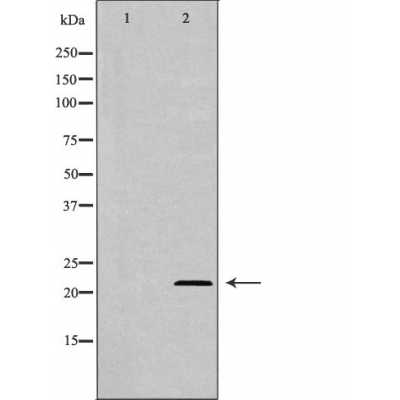AK1 Antibody - #DF6350
| Product: | AK1 Antibody |
| Catalog: | DF6350 |
| Description: | Rabbit polyclonal antibody to AK1 |
| Application: | WB IHC |
| Reactivity: | Human, Mouse, Rat |
| Prediction: | Pig, Zebrafish, Bovine, Horse, Sheep, Rabbit, Dog, Chicken, Xenopus |
| Mol.Wt.: | 22kDa; 22kD(Calculated). |
| Uniprot: | P00568 |
| RRID: | AB_2838314 |
Product Info
*The optimal dilutions should be determined by the end user. For optimal experimental results, antibody reuse is not recommended.
*Tips:
WB: For western blot detection of denatured protein samples. IHC: For immunohistochemical detection of paraffin sections (IHC-p) or frozen sections (IHC-f) of tissue samples. IF/ICC: For immunofluorescence detection of cell samples. ELISA(peptide): For ELISA detection of antigenic peptide.
Cite Format: Affinity Biosciences Cat# DF6350, RRID:AB_2838314.
Fold/Unfold
Adenylate kinase 1; Adenylate kinase isoenzyme 1; Adenylate kinase soluble; AK 1; Ak1; ATP AMP transphosphorylase; ATP-AMP transphosphorylase 1; KAD1; KAD1_HUMAN; Myokinase;
Immunogens
A synthesized peptide derived from human AK1, corresponding to a region within the internal amino acids.
- P00568 KAD1_HUMAN:
- Protein BLAST With
- NCBI/
- ExPASy/
- Uniprot
MEEKLKKTKIIFVVGGPGSGKGTQCEKIVQKYGYTHLSTGDLLRSEVSSGSARGKKLSEIMEKGQLVPLETVLDMLRDAMVAKVNTSKGFLIDGYPREVQQGEEFERRIGQPTLLLYVDAGPETMTQRLLKRGETSGRVDDNEETIKKRLETYYKATEPVIAFYEKRGIVRKVNAEGSVDSVFSQVCTHLDALK
Predictions
Score>80(red) has high confidence and is suggested to be used for WB detection. *The prediction model is mainly based on the alignment of immunogen sequences, the results are for reference only, not as the basis of quality assurance.
High(score>80) Medium(80>score>50) Low(score<50) No confidence
Research Backgrounds
Catalyzes the reversible transfer of the terminal phosphate group between ATP and AMP. Also displays broad nucleoside diphosphate kinase activity. Plays an important role in cellular energy homeostasis and in adenine nucleotide metabolism.
Cytoplasm.
Consists of three domains, a large central CORE domain and two small peripheral domains, NMPbind and LID, which undergo movements during catalysis. The LID domain closes over the site of phosphoryl transfer upon ATP binding. Assembling and dissambling the active center during each catalytic cycle provides an effective means to prevent ATP hydrolysis.
Belongs to the adenylate kinase family. AK1 subfamily.
Research Fields
· Metabolism > Nucleotide metabolism > Purine metabolism.
· Metabolism > Metabolism of cofactors and vitamins > Thiamine metabolism.
· Metabolism > Global and overview maps > Metabolic pathways.
Restrictive clause
Affinity Biosciences tests all products strictly. Citations are provided as a resource for additional applications that have not been validated by Affinity Biosciences. Please choose the appropriate format for each application and consult Materials and Methods sections for additional details about the use of any product in these publications.
For Research Use Only.
Not for use in diagnostic or therapeutic procedures. Not for resale. Not for distribution without written consent. Affinity Biosciences will not be held responsible for patent infringement or other violations that may occur with the use of our products. Affinity Biosciences, Affinity Biosciences Logo and all other trademarks are the property of Affinity Biosciences LTD.
